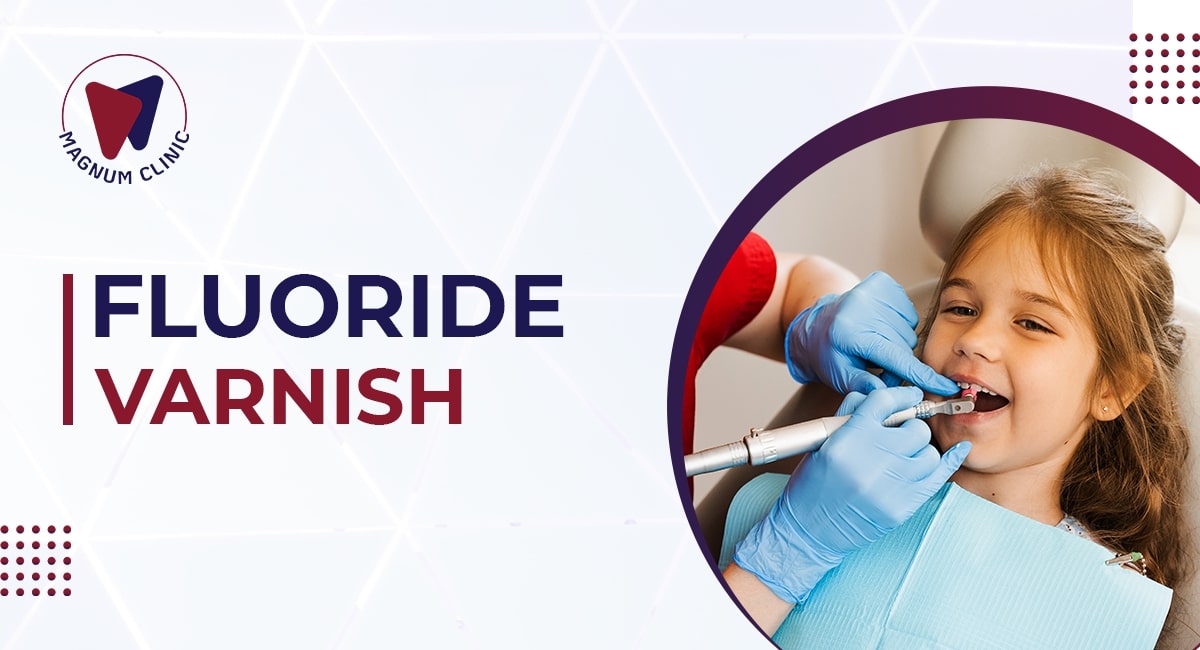Fluoride Varnish Dental Treatment, Indications and Contraindications

Fluoride varnish dental treatment is a dental procedure that involves the application of a concentrated fluoride solution to the teeth. This dental varnish treatment is a quick and effective way to strengthen tooth enamel, prevent tooth decay, and reduce tooth sensitivity. It forms a protective layer over the teeth, releasing fluoride slowly to promote remineralization and combat the effects of acids and bacteria.
Fluoride varnish is commonly used in both pediatric and adult dentistry as a preventive measure, offering a simple and painless solution to enhance oral health and maintain strong, cavity-resistant teeth.
Magnum Clinic boasts a team of top-tier pediatricians specializing in fluoride varnish dental treatments for children, ensuring that your child's oral health is in expert hands.
Varnish dental is highly concentrated form of fluoride applied to tooth surface by dentist.
Fluoride Varnish Indications:
1.Caries active individuals.
2.As a primary preventive measure for moderate and high caries risk patients.
3.Children shortly after period of tooth extraction.
4.Children aged 5 and younger.
5.Desensitizing agent for exposed roots.
6.On advance enamel carious lesions.
7.Fluoridated cavity varnish.
8.Around orthodontic bands and brackets.
9.Patient with fixed and removable prosthesis.
10.Individuals under medication that decrease salivary flow.
11.Mentally and physically challenged individuals.
Fluoride Varnish Contraindications
Fluoride varnish is generally safe and well-tolerated, but there are a few contraindications to consider. It should be avoided in individuals with a known allergy to fluoride or any of the varnish's components. Additionally, it's not recommended for those with open sores, wounds, or inflamed tissue in the oral cavity. Patients with severe respiratory issues or those unable to expectorate (spit out) the excess varnish should also avoid this treatment. Dentists carefully evaluate a patient's medical history and oral condition to ensure that fluoride varnish is appropriate and safe for them.
1.Patients with low caries risk.
2.Treatment areas of aesthetic concern.
3.Patient with ulcerative gingivitis and stomatitis.
FAQs - Fluoride Varnish Dental Treatment
What should I expect during the application process?
Fluoride varnish will be painted on your child’s teeth in a quick and easy process. Despite being well accepted by children, there is a possibility that your child may cry during the application. Babies and children do not like having things put in their mouth. child’s teeth to be dull yellow after the fluoride varnish is painted on, this yellow color will come off the moment you brush your child’s teeth.
Is Fluoride Varnish Safe?
Fluoride varnish is safe and used by dentists and doctors all over the world to help prevent tooth decay in children. Only a small amount is used, and hardly any fluoride is swallowed. It is quickly applied and hardens, fluoride varnish make teeth look yellow or teeth look dull. However, the color of your child's teeth will return to normal after the fluoride varnish is brushed off.
How Do I Care for My Child's Teeth After Fluoride Varnish is Applied?
Your child can eat and drink right after the fluoride varnish is applied. But only give your child soft foods and cold or warm (not hot) foods or liquids and avoid hard and sticky foods for 24hours child is not supposed to brush or floss teeth for at least 4 to 6 hours or to wait until the next morning to brush or floss .
How often should Fluoride Varnish be applied?
Fluoride varnish can be applied up to 4 times per year or every 3 months. Studies show that children who get fluoride dental varnish every 3 months have fewer cavities than those who get it less often or not at all.
What is fluoride varnish?
Varnish dental treatment is involves the application of a concentrated fluoride solution to the teeth. This procedure helps strengthen tooth enamel, prevent tooth decay, and reduce tooth sensitivity by forming a protective layer that releases fluoride slowly, promoting remineralization and providing a defense against acids and bacteria. It's commonly used in both pediatric and adult dentistry as a preventive measure for maintaining strong, cavity-resistant teeth.
